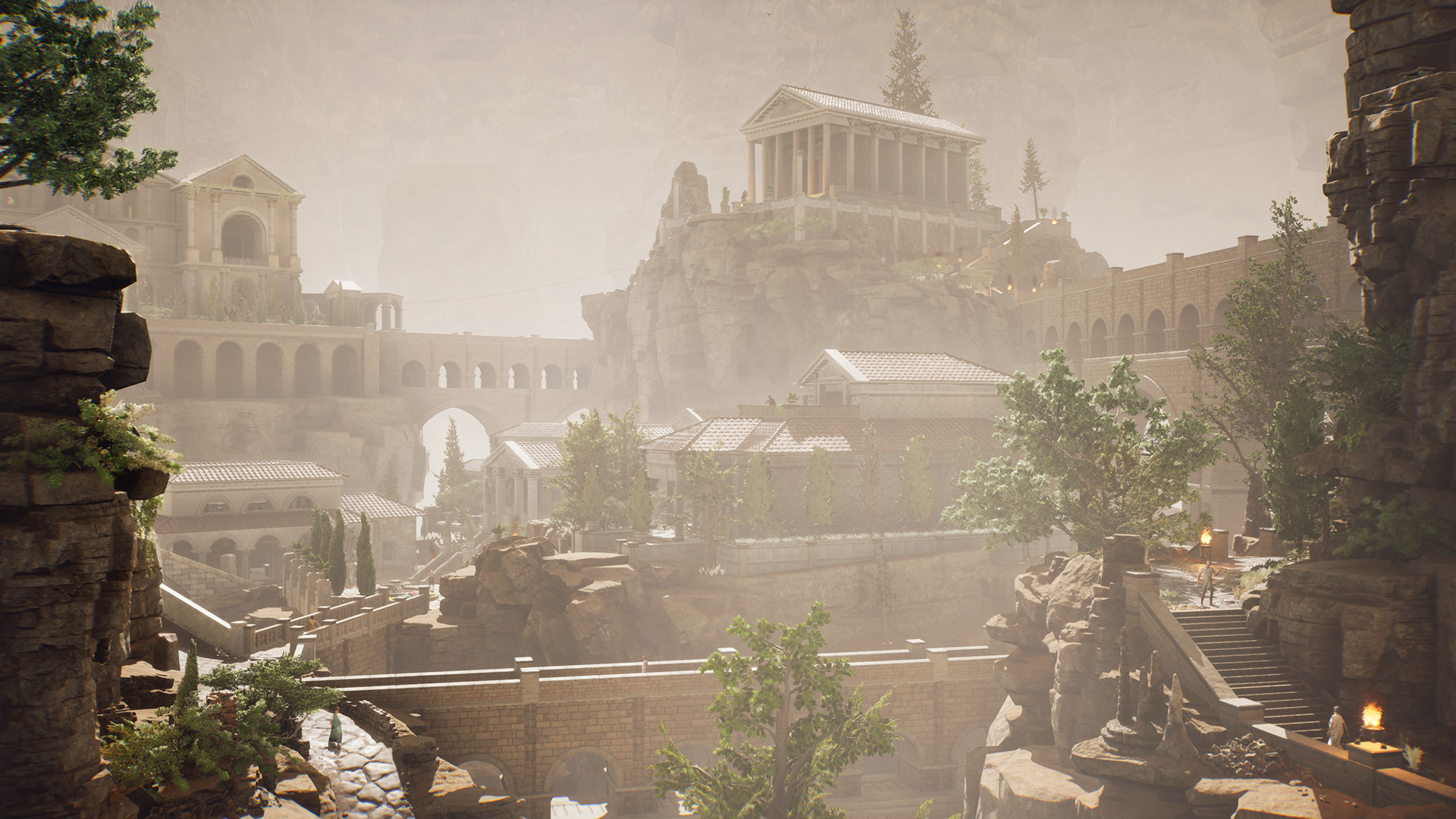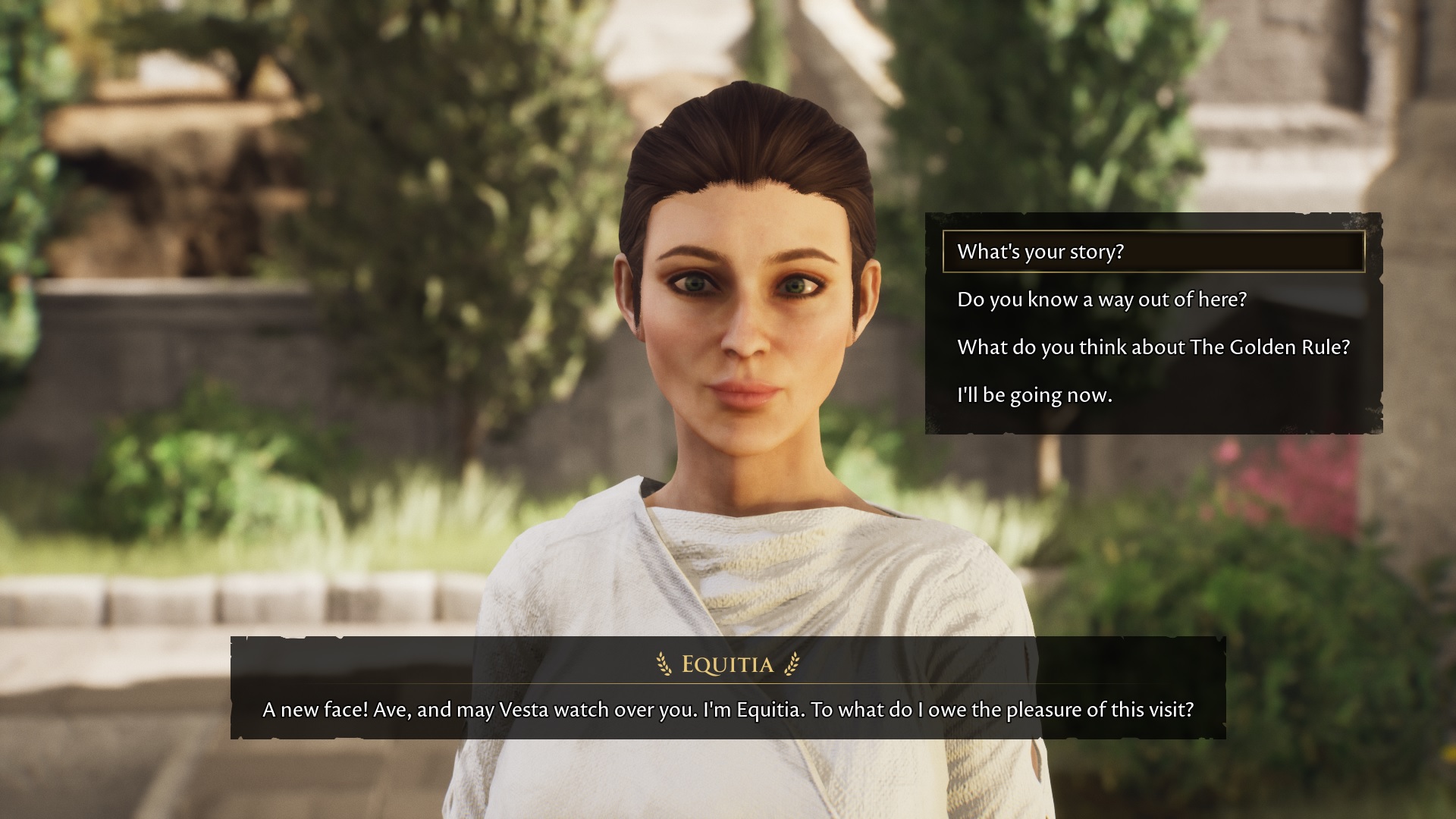You awake on the banks of the Tiber River. How did you get there? Why are you there? And what year is it? The answer to the last question is ostensibly “the present day.” However, once you head into the nearby Roman ruins, you find yourself transported 2,000 years into the past. Arriving at a city you can’t escape, you meet the various denizens of the ancient locale. They warn you about a curse on the city. Anyone who commits a sin will cause the death of every person in the city. Death by getting turned into gold, no less. How could it get worse? Well, somebody is planning on sinning. And it’s up to you to stop them. Maybe you’ll even uncover more mysteries of the city along the way.
This is the central premise of The Forgotten City. Initially created as a mod for The Elder Scrolls V: Skyrim by writer Nick Pearse, the full game came to fruition after Pearce formed development team Modern Storyteller. It’s a testament to the dedication of Pearce and his team that the new iteration of The Forgotten City turned out so well. Clearly, they knew they had something on their hands with the success of the mod, and worked to flesh out that concept into a more expansive experience.
Game Name: The Forgotten City
Platforms: PlayStation 4 (reviewed), PlayStation 5, PC, Xbox One, Xbox Series X/S Nintendo Switch
Developer: Modern Storyteller
Publisher: Dear Villagers
Release Date: July 28th, 2021 (PlayStation, Xbox, and PC), September 23rd, 2021 (Switch)
Price: $24.99 (Digital), $39.99 (Physical)
Entering the forgotten city itself, players emerge from dark tunnels to see a dazzling Roman city in front of them. Light streams from way up above and illuminates the many columns and arches of the classical buildings. Aqueducts carry water throughout the city and tall trees line walkways thanks to the hard efforts of some Roman landscaper. But really, the designers built a beautiful city, and it proves only the tip of the iceberg as players discover the areas around and beneath it. Styles sometimes comes at the expense of substance, as navigation is not always intuitive. The game doesn’t have a map, but it does boast a photo mode and several filters to showcase the visuals in different lights.
Let’s Do the Time Warp Again
But while I could continue talking about the beautiful visuals, the real high mark of the game comes from the writing and gameplay. Not only does the game send you back in time, but it allows you to rewind time and repeat the day with the knowledge you’ve gained. Imagine an episode of Doctor Who with a splash of Groundhog Day, and you’ve got the general gist of the game. On a side note, the game also contains the wry humor of both. You can say things the characters wouldn’t possibly know and preempt their conversation topics as you relive the same day over and over.
This last bit serves up humor but also speaks to the way the game sidesteps the pitfall of repetition. Not only can you skip conversations you’ve had, but you can even send trusty town greeter Galerius to carry out tasks you previously accomplished. Each time you reset the day, the game keeps track of your overall progress. It even lets you keep any items you recovered on previous excursions through time. Procure the antidote for a poisoned plebeian after their death? Restart the day and give it to them first thing. The retention of items and knowledge after rewinding time serves as the crux for many of The Forgotten City’s puzzles. Combat occasionally appears almost as an afterthought and it’s mostly avoidable.
Philosophy 101
For the ethical dilemmas at the heart of the game, your wits are your greatest weapon. The characters in the city come from all over the Roman Empire, and the game makes the most of the inherent diversity in this setting. Each resident has their own belief system and views on morality. This comes into play with the central questions at the heart of the city’s curse. What constitutes a sin? Is there such a thing as an objective view of right and wrong? Do the needs of the many outweigh the needs of the few? In a city with the motto “the many shall suffer for the sins of the one,” navigating sticky ethical situations is the game’s bread and butter. Just make sure you don’t accidentally turn that bread and butter into gold.
The drawback of this concept is that while the game posits itself as impartial, it still wants you to navigate the problems of the characters in set ways. Let’s say you fail a given dilemma. Did you make the wrong dialogue choice or are you missing a key item or piece of information? The game can get a bit obtuse. Luckily, trying again is only a matter of a quick reset of the clock. And when the deduction system works, which it usually does, it proves quite satisfying. Gathering the bits of info and evidence you need and making your rhetorical case succeed, you feel like a detective wrapped in a Roman tunic.
The Forgotten City Review
The Forgotten City
The Forgotten City boasts a rich gameplay experience that lives up to the ingenuity of its clever premise. As a role-playing choice-based mystery, the game offers a compelling narrative with some engaging existential questions at its center. With four distinct endings, it gives players a decent enough amount of leeway for approaching moral quandaries. And as a way of both solving puzzles and fixing mistakes, the time travel mechanic is worth its weight in… some sort of precious transition metal.
Pros
- Intriguing and well-written mystery with twists and turns.
- Great voice acting and distinct characters.
- Gorgeous visuals.
- Clearly a well-researched game.
Cons
- Occasionally frustrating lack of guidance.
-
The Forgotten City Review




